Gerry Adams's Blog, page 64
September 25, 2013
Thank you Seamus Heaney
Thank you Seamus Heaney
On Tuesday evening the Dáil set aside its normal business to remember Seamus Heaney. The deep sense of loss and of affection for Seamus was evident in all of the contributions.
In the days after his death I wrote of my own sorrow at his passing and yesterday, speaking in the Dáil, I again expressed the great sadness that engulfed millions when we learned of his passing.
This is some of what I said:
Seoid náisiúnta ab ea Séamus. Táimid fíor-bhuíoch do Marie agus a teaghlach mar thug siad Seamus duinn. He was extremely modest, approachable and humble, and had a great sense of humour. He had a profound and humane understanding of us as a people because he was of us as a people, with all our faultlines, flaws, strengths and weaknesses. Until his death, he was the world's leading living poet in the English language…
In Long Kesh, where I was a prisoner for a time, I remember one 12 July sitting with a couple of other prisoners in a cage. We could hear the Orange drums outside on Blaris Road. To our surprise, one of our comrades started to recite, from memory, the poem OrangeDrums, Tyrone, 1966:
The lambeg balloons at his belly, weighs
Him back on his haunches, lodging thunder
Grossly there between his chin and his knees.
He is raised up by what he buckles under.
Each arm extended by a seasoned rod,
He parades behind it. And though the drummers
Are granted passage through the nodding crowd
It is the drums preside, like giant tumours.
To every cocked ear, expert in its greed,
His battered signature subscribes ‘No Pope’.
The pigskin’s scourged until his knuckles bleed.
The air is pounding like a stethoscope.
I do not think any of us could make reference to Seamus Heaney without referencing the Cure at Troy. It is so true. It reads:
Human beings suffer,
They torture one another,
They get hurt and get hard.
No poem or play or song
Can fully right a wrong
Inflicted and endured.
The innocent in gaols
Beat on their bars together.
A hunger-striker’s father
Stands in the graveyard dumb.
The police widow in veils
Faints at the funeral home.
History says, don’t hope
On this side of the grave.
But then, once in a lifetime
The longed-for tidal wave
Of justice can rise up,
And hope and history rhyme.
So hope for a great sea-change
On the far side of revenge.
Believe that further shore
Is reachable from here.
Believe in miracle
And cures and healing wells.
In these days of turbulence and change in the North, we should be ever mindful that a further shore is reachable from here and we should reach for it.
Thank you Marie, Catherine Ann, Christopher and Michael. Go raibh míle maith agaibh. Thank you, Seamus Heaney.
Published on September 25, 2013 02:23
September 24, 2013
Symphysiotomy report makes grim reading
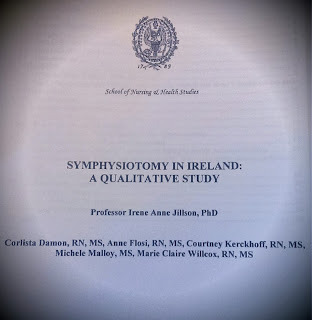 Until I stood for the Dáil in County Louth I had never heard of symphysiotomy. Several women victims of this barbaric practice came to see me to explain what had been done to them and to outline their long campaign for justice. For those of you who don’t know what it is or entails; symphysiotomy is a surgical procedure used in the arrest of descent during the second stage of labour in order to increase the diameter of a woman’s pelvis and allow for a vaginal birth. Initiated in France in the 18th century, this procedure involves severing the cartilage that connects the symphysis pubis with a scalpel under local anaesthesia, followed by unhinging of the pelvic bones to the extent needed for delivery
Until I stood for the Dáil in County Louth I had never heard of symphysiotomy. Several women victims of this barbaric practice came to see me to explain what had been done to them and to outline their long campaign for justice. For those of you who don’t know what it is or entails; symphysiotomy is a surgical procedure used in the arrest of descent during the second stage of labour in order to increase the diameter of a woman’s pelvis and allow for a vaginal birth. Initiated in France in the 18th century, this procedure involves severing the cartilage that connects the symphysis pubis with a scalpel under local anaesthesia, followed by unhinging of the pelvic bones to the extent needed for deliveryI was outraged by their personal stories of pain and abuse and moved by their courage and resilience. In the years since then the campaign has increased pressure on the government to address this issue in a way that is satisfactory to the remaining women survivors. As part of Sinn Féin’s efforts we have raised this issue in the Dáil and in the media but we also saw the value in raising this issue internationally.
As part of this I introduced some victims of symphysiotomy to Professor Irene Anne Jillson PhD. Irene has an international reputation in global health generally and in women’s health. She and four graduate nursing students voluntarily undertook a study of symphysiotomy, even paying their own travel and other expenses. Today has seen the publication of their report by the prestigious School of Nursing and Health Studies at Georgetown University. Symphysiotomy in Ireland: A Qualitative Study’ makes grim reading. It is a detailed expose of the cruel and inhuman use of Symphysiotomy on women in Ireland.
The focus of the study was to explore ‘the factors that contributed to the use of Symphysiotomy’ in Ireland from 1944 to 1984 and to examine the impact it had on the women victims. Unusually the study also spoke to the husbands of women who had suffered Symphysiotomy and heard from them for the first time of the trauma of this practice on their wives and families. The report also reveals that the procedure was often carried out without a women’s ‘understanding or consent. Most of the 1500 or more Irish women on whom symphysiotomies had been performed and who were alive in 1999, learned for the first time in that year, that the procedure had been performed on them, as a result of a newspaper article based on a doctoral thesis.’
Professor Jillson and two colleagues carried out exhaustive interviews with participants who in the main are between 60-80 years of age and live in Louth. The report records their experience and in their own words details their lack of consent to symphysiotomy and the lack of information available to them. Professor Jillson notes that ‘most women in the study reported that they had either never heard of the procedure or didn’t know what the procedure was at the time of their delivery … Doctors rarely gave an explanation of what they were doing before or during the procedure.’
And even after the procedure many women didn’t know what had been done to them. The report pulls no punches in describing the pain that the women experienced. It reports that: ‘The physical distress following the symphysiotomy procedure was significant for nearly every woman interviewed. Women consistently reported chronic pain, fatigue, urinary tract infections, incontinence, difficulty walking, limited mobility, and pain during sexual intercourse. Many are confined to wheelchairs and/or have to walk with the assistance of a cane or walker. With regard to incontinence, one woman described continued problems with incontinence, which is both embarrassing and inconvenient. In describing her lack of bowel control, one woman shared, “I had no muscular control…It felt like a herd of elephants had walked all over me body.”
Pain pervaded the daily lives of many of the participants, altering the amount they could work and the amount of energy they had to carry out activities of daily living. Back pain was a persistent problem that limited the mobility of many of the women, and continues to do so.’
When asked what they now wanted most women said they wanted an explanation, transparency and an apology from those involved.
The experience of victims of symphysiotomy is expressed tellingly by one respondent who describes symphysiotomy as evil. She said: ‘One word: evil. Pure evil. It’s like a witch doctor participated in the abuse of women’s bodies. That’s what I feel.’ Another described it as ‘a curse one would not wish on my worst enemy.’
Recently the Minister for Health James Reilly refused to publish the second part of the report into symphysiotomy by Professor Oonagh Walsh. The Minister said he didn’t want to publish it until after the government has reached its decision on this issue.
This isn’t good enough. The victims, their families and supporters have a right to see all of the available information about the use of symphysiotomy and its effect on the women and their husbands and families.
There are only around 200 survivors alive. They are all very elderly and carry deep physical and emotional scars from their experience. Some are quite frail. They simply cannot afford to wait months or longer for justice. Time is therefore of the essence.
The Ministers claim that it is ‘open to any woman not wishing to pursue mediation to bring a claim through the courts’ ignores the fact that many of the women cannot do this because of the Statue of Limitations.
In April the Government supported the Statute of Limitations (Amendment) Bill 2013, introduced by Caoimhghín O Caoláin TD, which seeks to accommodate access to the courts for all victims of symphysiotomy who would choose that course of action. However the government is preventing further progress on this.
The process of securing justice for these women victims is very important. The government is adding to the stress on victims and is ignoring the Dáil, by refusing to publish the Walsh report.
The victims of symphysiotomy must have the right to decide which course of action is best for them in their efforts to secure justice and compensation. To do that the government must publish the Walsh report; the terms of reference for the Judge and mediation process; a fixed and short timeframe for this process to take place and assist the passage of the Statute of Limitations (Amendment) Bill 2013.
The report by Professor Jillson is a welcome addition to the body of medical evidence and information now available.
Published on September 24, 2013 10:12
September 1, 2013
Deeply Sad at death of David Frost – Gerry Adams
I have just heard of the death of David Frost. Very sad news. I was interviewed by David many times. He was always courteous, good humoured, well researched and keenly interested in Ireland and the peace process. There was always a depth to his interviews that is frequently missing in others. David’s style of interview was unique and effective.
He once explained to me that there are two types of interview. One in which the interviewer attacks like a blizzard, a storm, and the response of the guest is to button up, put on the big overcoat and go into protective mode.
The other is to come at the guest like a sunny day. This encourages the guest to take off their jacket and relax. In this way you get the more informed and interesting interview. Consequently he was the master of the great interview.
To his family and friends I want to extend my sincere sympathies and condolences. Ar dheis Dé go raibh a anam
Published on September 01, 2013 04:35
August 30, 2013
Seamus Heaney - A national treasure is lost
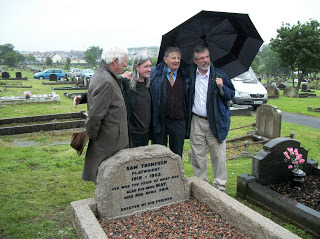 Seamus Heaney, Warren Thompson, Jimmy Ellis and mise at Sam Thompson's graveside Seamus Heaney is dead. When I heard the news this morning I was cleaning out a shed. Dirty and dusty and lost in that chore I got the news by text. I was deeply shocked. I stood for a while trying to take it in. I still can’t quite believe it. Although I have known Seamus personally for many years like millions of others I first knew him through his words – and what words. As a result I seem to have known him most of my life. And now he’s gone.
Seamus Heaney, Warren Thompson, Jimmy Ellis and mise at Sam Thompson's graveside Seamus Heaney is dead. When I heard the news this morning I was cleaning out a shed. Dirty and dusty and lost in that chore I got the news by text. I was deeply shocked. I stood for a while trying to take it in. I still can’t quite believe it. Although I have known Seamus personally for many years like millions of others I first knew him through his words – and what words. As a result I seem to have known him most of my life. And now he’s gone.Seamus was a national treasure. He was of us with a profound and humane understanding of us as an island people with all our fault lines and flaws and strengths. He was extremely modest, approachable and humble. And until his death this morning the world’s greatest living poet in the English language.
His name is spoken of in awe alongside those of Yeats, Joyce and Friel, O Connor and Kavanagh, and O Brien, O Casey and Shaw and so many of our other great writers and poets.
He was a proud Tamlaghduff man from County Derry who loved his place and people. And he wrote about them often. In his first major collection – Digging – he wrote of his father digging for potatoes and his grandfather cutting the turf ...
By God, the old man could handle a spade.
Just like his old man.
My grandfather cut more turf in a day
Than any other man on Toner’s bog.
Once I carried him milk in a bottle
Corked sloppily with paper. He straightened up
To drink it, than fell to right away
Nicking and slicing neatly, heaving sods
Over his shoulder, going down and down
For the good turf. Digging.’
He and Michael McLaverty both taught for a time in St. Thomas’s Secondary school on the Whiterock Road in west Belfast.
I first read Seamus Heaney in the early 1970’s. They were difficult and dangerous years. West Belfast, like other places was under British Army military occupation. Once while travelling on a bus down the Falls Road I was so busy reading his ‘Death of a Naturalist’, that he had published in 1966, that I failed to notice that the Brits had stopped the bus. It was the Parachute Regiment and they walked menacingly up and down asking passengers their names, addresses where they were going and checking this info with their Intelligence Officer and against cards of photos they carried with them of those they were hunting.
One Brit stared at me for a second and then questioned the passenger behind me. Everybody heaved a sigh of relief when they got off. From that point on Seamus Heaney became a sort of talisman for me.
In 2003 when I was writing ‘Hope and History’ which deals with the 80s and 90s and the birth and evolution of the peace process, I contacted Seamus and asked if he minded me quoting from his poem ‘The Cure at Troy’. It seemed to me then and today that ‘The Cure at Troy’ at once catches the despair of conflict and the hope of peace and justice. And ‘hope and history rhyme’. He generously agreed.

At Sam Thompson's rededication event
More recently in 2010 he returned to west Belfast for the rededication of a stone at the grave of playwright Sam Thompson and to speak about Michael McLaverty at a Féile an Phobail event in St. Mary’s University College on the Falls Road. Sam Thompson was a well known and influential writer. In 1959 the directors of the Group Theatre in Belfast refused to stage ‘Over the Bridge’ because of the way it highlighted sectarianism. The well known actor Jimmy Ellis left the group set up his own company and went ahead with the play in 1960.
Seamus and other contemporaries of Sam Thompson’s, including Sam’s son Warren and Jimmy Ellis gathered with the rest of us in the City Cemetery in the mizzley soft rain for a poignant little event. Although it is a story that will be told at another time the ceremony was hilarious and indeed ended up with Seamus giving the tribute to both Sam Thompson and Jimmy Ellis.
Afterwards Seamus and Marie Heaney went off with Danny Morrison to visit Saint Thomas’ School where Seamus and Michael McLaverty used to teach It was his first time there since 1961.By all accounts it was a very emotional visit for him. Incidentally in his poem ‘Whatever you say, say nothing’ he uses the line ‘is there a life before death’. That legend first appeared in neat white capitals on the wall of the city cemetery on the Whiterock Road. I saw it the first morning after it was painted.
His talk in the big hall in Saint Mary’s where he told us of the first time he saw his wife Marie were also emotional moments for this wonderful poet and thoroughly decent man. His tribute to McLaverty, because that is what it was, was peppered with humorous little insights and telling observations. We all sat enthralled. And then he read us some of his poetry. In many ways this visit was also a reconciliation. I think Marie understood that and she was delighted.
As well as being a wonderful human being Seamus was a literary figure of huge international stature, regarded by many as the greatest Irish poet since Yeats. In 1995 he was awarded the Nobel Prize for Literature. The Nobel citation described his poetry as ‘works of lyrical beauty and ethical depth, which exalt everyday miracles and the living past.’
Seamus was wise and modest and dazzled us constantly with his wordsmithery. His poetry uplifted and surprised us; challenged and brought comfort. He was in Derry during the Fleadh with Liam Óg O Flynn performing ‘The Poet and the Piper’. His verse ‘The Given Note’ involves two of my favourite pieces; Port na bPúcaí played by Liam and Seamus’s own ‘The Given Note’. I’m going to play the cd now.
Seamus knew his gift was a given but he worked at it. Magically weaving words, reliving memories, invoking imagination and emotion. Making us laugh and cry. And also making us think.
My thoughts at this time are with Seamus’ wife Marie and their children Christopher, Michael and Catherine Ann and his family.
But no celebration of his life would be complete without reference to ‘The Cure at Troy’ and his deep sense of hope for the future that underpins it.
Human beings suffer,
they torture one another,
they get hurt and get hard.
No poem or play or song
can fully right a wrong
inflicted or endured.
The innocent in gaols
beat on their bars together.
A hunger-striker's father
stands in the graveyard dumb.
The police widow in veils
faints at the funeral home.
History says, Don't hope
on this side of the grave.
But then, once in a lifetime
the longed for tidal wave
of justice can rise up,
and hope and history rhyme.
So hope for a great sea-change
on the far side of revenge.
Believe that a further shore
is reachable from here.
Believe in miracles
and cures and healing wells. Ar dheis Dé go raibh a anam
Published on August 30, 2013 08:35
August 29, 2013
‘I have a dream’ - Remembering Martin Luther King
Atlantain Georgiais where Martin Luther King was born and where he spent much of his life preaching. In March 2001 I had the good fortune of visiting Atlanta at the invitation of the Ancient Order of Hibernians and Friends of Sinn Féin. I was there to speak at several fundraisers.
It is a city inextricably linked to two of the great struggles in American history: the Civil War and the Civil Rights struggle. In 1864, after a four month siege by the Union armies the city surrendered and it was ordered to be burned to the ground by the union general William Tecumseh Sherman. Only its Churches and hospitals were spared.
In the 1950s and 60s it was at the heart of the Civil Rights struggle. No visit to Atlantais complete without walking through the Park and Preservation District. Martin Luther King’s home, where he was born in January 1929, is there. So too is the Ebenezer Baptist Church. It is an imposing brown brick building. Inside I had the opportunity to sit quietly and contemplate the efforts of all of those who marched and struggled for equality and civil rights.
This is where Martin Luther King Jr. preached his first sermon at the age of 17 and where he was co-pastor with his father for eight years. In 1957 an organisational meeting of the Southern Christian Leadership Conference was held there and Martin Luther King Jr became its first President. It played a key role in the Civil Rights struggle. It is a building which resonates with the words and deeds of freedom.
A short distance away is the King Centre with its impressive Visitors Centre and the graveside of Martin Luther King Jr.
I tell you all of this because it’s part of my history. Like many of my generation I was hugely influenced by the civil rights movement in the United States. ‘We shall overcome’ was adopted as the slogan for the Irish Civil Rights Association after its formation in 1967 and the courage and heroism of Rosa Parks and others inspired us in our opposition to discrimination in housing and jobs and our demand for the right to vote.
Rosa Parks’ refusal in 1955 to sit at the back of the bus in Montgomery, Alabama; her arrest and the boycott of the bus company was a pivotal moment in that historic struggle. It was also evidence that one person can make a difference.
During one of my first visits to the United States I had the privilege and honour to meet Rosa Parks, a small diminutive woman of tremendous strength of character and determination.
50 years later their efforts have brought about enormous change in American society. This has been most obvious in the election of a black President but intolerance and racism and inequality in employment still exist.
Yesterday – Wednesday August 28th – President Obama spoke at the Lincoln Memorial in Washingtonwhere 50 years ago Martin Luther King gave his seminal ‘I have a dream speech’. A quarter of a million people took part in that 1963 March for Jobs and Freedom.
In his historic address that day the civil rights leader reminded his audience that 100 years earlier Abraham Lincoln had signed the Emancipation Proclamation which gave hope to millions of slaves. But ‘the life of the negro is still crippled by the manacles of segregation and the chains of discrimination’ . Martin Luther King spelt out his dream, his vision, his aisling for the future. A dream in which no one will be judged by the colour of their skin.
Last weekend tens of thousands of American citizens took to the streets of the US capital to celebrate that momentous event.
But as Martin Luther King III, the eldest son of the assassinated civil rights leader pointed out; ‘This is not the time for nostalgic commemoration, nor is this the time for self-congratulatory celebration. The task is not done. The journey is not complete. We can and we must do more.’
And therein lies the great truth of all struggles for freedom and human and civil rights whether in the United States or Ireland or South Africa – it is a constant battle for change, for improvement, for redefining our relationships with each other. And it’s about creating the conditions whereby people are empowered to make that change.
Speaking to the First Annual Institute on Non-Violence and Social Change in Montgomery in December 1956 King told his audience that freedom and justice and positive change are not inevitable. He warned that ‘history has proven that social systems have a great last-minute breathing power and the guardians of a status quo are always on hand with their oxygen tents to keep the old order alive.’
These words of warning apply as much today to the island of Ireland as they did 50 years ago. The peace process has brought about many changes. Ireland today is a country in transition. A lot of the old conservative influences have been weakened and progress has been made.
But it is equally clear that there is still huge resistance to change. We still have a lot of work to do to build the republic that is envisioned in the 1916 Proclamation – an Ireland free of division and injustice and fear; an Ireland in which the wealth of the nation is invested creatively and more fairly; an Ireland in which there is equality and justice and freedom.
As we continue our journey forward the words and deeds of Martin Luther King and Rosa Parks and others will continue to inspire us.
In his 1956 speech King concluded his remarks by arguing that we all must have the courage to ‘stand up and protest against injustice wherever we find it.’
He said: ‘ There is nothing in all of the world greater than freedom. It is worth paying for; it is worth losing a job; it is worth going to jail for. I would rather be a free pauper than a rich slave. I would rather die in abject poverty with my convictions than live in inordinate riches with the lack of self respect.’
Published on August 29, 2013 06:31
August 14, 2013
Supporting the Ballymurphy Families
The decision by the British Secretary of State, the PSNI and the HET to try to prevent inquest and trial transcripts from being given to the families of three victims of the conflict has again focussed attention on the refusal of the British government to deal properly with victims and their families, and in particular the victims of British state violence.
Patrick McAdorey was killed by the British Army on August 9th 1971; Sarah Larmour was killed by the UVF on October 3rd 1979 and Michael Donnelly was killed by the British Army on August 9th 1980. Their families want to know what happened and why.
The Minister for Culture, Arts and Leisure Caral Ni Chuilin sought and was given the go-ahead by the north’s Attorney General for the inquest papers and trial transcripts to be handed over to Relatives for Justice and to the families. All of these documents are already in the public domain and were reported in the media at the time.
Until 2012, these types of papers were routinely disclosed by the Public Records Office to relatives and their legal representatives. That changed last summer, when the PSNI/HET attempted to introduce itself as a new gatekeeper over the disclosure of all such Public Records, without the permission or knowledge of the DCAL Minister. That is at the heart of this latest issue.
The desire of the British state and its agencies to withhold information about its actions in the north is at the heart of this issue. Consequently, they sought and secured an injunction against any public dissemination of the files. We now have to wait until later on Thursday to find out what happens next.
This is not a new approach by the British government. Successive British governments have steadfastly refused to deal comprehensively with the issue of victims. Bloody Sunday was one example. This current court case is another. So too is the British refusal to deal honestly with the families of the Ballymurphy and Springhill massacres. 11 citizens from the Ballymurphy area, including a local priest and mother of 8 were killed by the Paras in a 36 hour period following the introduction of internment on August 9th 1971. They were among 20 people, including IRA Volunteer Patrick McAdorey, who were killed by the British Army in the north in the week after August 9th.
Five months later the same regiment killed 14 people in Derry and six months after that they returned to the greater Ballymurphy area and shot dead another five citizens, three of whom were children. They also killed another priest.
Last Sunday the relatives of the Ballymurphy victims held a march and rally to highlight their demand for truth. They and the Springhill relatives have demonstrated extraordinary courage and determination in the face of British secrecy and obstruction over many difficult years.
Their tenacity and resolve has seen the families compile significant evidence which shows that all who died were killed unlawfully and in breach of Article 2 of the European Convention on Human Rights (ECHR).
The Ballymurphy case also raises serious questions regarding human rights abuses committed by the British Army and of the culture of impunity that allowed members of British state forces to routinely carry out violent actions without fear of being held accountable.
In November 2011 the families succeeded in persuading the newly appointed Attorney-General that new inquests should be held.
While this was a welcome development the families are understandably concerned about the limitations of an inquest to investigate the context, circumstances and aftermath of the deaths of their loved ones. They also have no confidence in the review of the deaths by the Historical Enquiries Team (HET) within the PSNI.
They question the independence of the HET and as the recent report by Professor Patricia Lundy concluded there is much that is wrong with the HET. The families have also met two British Secretaries of State who were less than helpful.
They have spoken to the Taoiseach and to Irish government officials but with little evidence that they are challenging the British position.
Undeterred by all of this the Ballymurphy families have proposed a new initiative to get to the truth. They are seeking the appointment of an Independent Panel to examine all of the documents relating to the context, circumstances and aftermath of the deaths of their loved ones.
The Panel would investigate the role of the British Government, British Army, and criminal justice agencies such as the RUC, DPP, the Coroner’s Office and the significance of the media; as well as secure the public disclosure of all of the available documents. It would publish a detailed, comprehensive report demonstrating how the disclosed documents add to public understanding of these events, their investigation and the consequences.
The families’ proposal is based on the terms of reference of the British Government funded work of the Hillsborough Independent Panel. I support their proposal. It is an innovative approach to the issue of truth and I would urge everyone interested in supporting the families to back their proposal and to join with them in demanding that the British government establish an Independent Panel.
However it is specific to these cases and will not help the hundreds of other families that have been bereaved or hurt. As the current court case involving Relatives for Justice demonstrates there is a need to construct a different approach, one which involves in the international community.
My experience in working with victims’ families has convinced me that only a statutory process of truth recovery facilitated by an acceptable international agency holds any prospect of addressing the needs of victims and families.
Published on August 14, 2013 03:22
August 9, 2013
Adams responds to Statement by Stack Family
Brian Stack was the chief officer in Portlaoise prison in March 1983 when he was shot and grievously wounded. The IRA said it was not involved. A year and a half later Brian Stack died as a result of his injuries.
Mr. Stack was a married man with three young sons. Since then the family have sought answers to questions about who shot their father and why.
At the beginning of May I met Austin and Oliver Stack in Leinster House. They asked for my assistance in seeking answers and closure to questions they had surrounding the killing of their father. I told them I would try to help.
From that time I worked with Austin and Oliver to establish whether the IRA was involved in their father’s death.Recently I accompanied Austin and Oliver to a meeting with a former IRA leader who had enquired into the events of March 1983.
The substance of his conclusions are contained in the family statement which states that the former IRA leader: “ Acknowledged that the IRA was responsible for the death of Chief Officer Brian Stack and that IRA members acting under orders carried out this attack. We were further informed that the IRA leadership had not sanctioned the attack and upon becoming aware that its members, acting under orders, carried out the attack, the IRA disciplined the member responsible for issuing the instruction.
The statement also expressed regret that it had taken so long to clarify this matter and acknowledged that the attack should not have taken place. An expression of sorrow for the pain and hurt suffered by our family was also included.”
Also in their statement the family said: “This process has brought an element of closure to our family …”
I want to pay tribute to the Stack family – to Sheila Stack and her sons, Austin, Kieran and Oliver.On behalf of Sinn Féin I extend my regret at the killing of Brian.
I hope that these recent developments will help them achieve the closure they have sought for 30 years.Addressing complex and painful legacy issues is an enormous challenge.
Dealing with the human consequences of conflict in terms acceptable to victims and their families is very difficult, especially in the absence of a process which provides for the voluntary participation of witnesses.Nonetheless it is a challenge which republicans will not shy away from.
This generation of republican activists who lived through and survived the war have a duty and a responsibility to do our best to help victims and families.
Published on August 09, 2013 16:38
August 2, 2013
Heroic response to Hospital flood
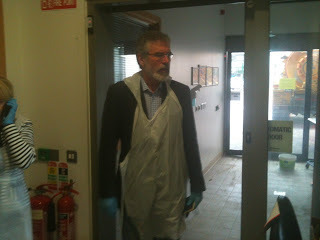
The stream behind Letterkenny Hospital seemed so innocent and innocuous. There was no huge torrent of water rushing through the culvert. It was hardly more than a small stream of water. It looked harmless and it was hard to imagine that last Friday evening it turned into a tidal wave of destruction that swept through the hospital leaving devastation in its wake.
Yesterday morning Padraig McLaughlin TD, and Councillors Gerry McMonagle and Micky McMahon and I visited the hospital to see for ourselves the damage wreaked when the stream burst its banks and contaminated water a metre deep cascaded down through the hospital. Workmen were busy clearing away debris from the stream and from along its course to prevent a recurrence. An independent civil engineering review is currently being carried out to establish what happened and why, and to make recommendations to ensure it doesn’t happen again.
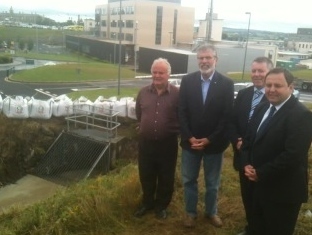 The Culvert and Hospital
The Culvert and Hospital
But around 5pm last Friday a deluge of rain saw the culvert break its bank and flood through Letterkenny hospital putting some 40% of the hospital out of action in a frightening and shocking one hour period. Youtube has video of the water rushing down corridors. Staff we spoke to recounted how they desperately moved seriously ill patients out of flooded rooms along debris strewn corridors. Remarkably no one was injured. The hospital staff and emergency services performed heroically and succeeded in getting patients to safety.
Sean Murphy the hospital’s General Manager and Anne Flood the Head of Nursing explained the scale of the emergency but also outlined their efforts to get services back up and running as quickly as possible. As we spoke in a conference room on the ground floor a large lorry arrived outside with a CT scanner. It will be parked in the grounds and put to work. It will be joined by X-ray equipment and an MRI also in lorries.
The extent of the damage is evident in the list of departments closed – the emergency department; the acute medical assessment unit; haematology and oncology; the outpatient department; the radiology department; coronary care; kitchens and support service offices. We spoke to Irish Army soldiers preparing to move medical records. The depth of the water has also meant that some 10,000 files have been damaged and contaminated and will need to be carefully cleaned by specialists.
For patients this is of particular concern as their future treatment will be determined by what those records contain.
The hospital management say that they have received outstanding support from everyone. There has thus far been no quibbling over money and resources. Altnagelvin hospital in Derry and Sligo hospital have picked up some of the work of Letterkenny. Nursing staff and doctors from Letterkenny are travelling to Derry to help Altnegelvin treat Donegal patients. Normally for medical staff to get accreditation to allow them to work in a different jurisdiction would take several months but the respective professional and health providers are co-operating to get this done in days.
The staff, emergency services and Donegal community have rallied to the hospital and are determined to repair all of the damage. It is vital that the government and the HSE step up to the mark and commit themselves to what will be a long term commitment to restore Letterkenny hospital.
Some older parts of the hospital may need to be replaced but even the newer buildings affected have been badly contaminated by the water damage and require significant infrastructure work.
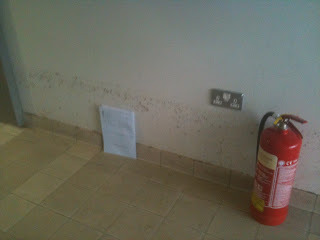 The tour of the hospital revealed to us the extent of the devastation. In one place a line of dirt showed the height the water had reached in the corridors. A lot of the equipment has already been cleaned but the contamination means that specialist cleaning will be required and major infrastructure repairs carried out.
The tour of the hospital revealed to us the extent of the devastation. In one place a line of dirt showed the height the water had reached in the corridors. A lot of the equipment has already been cleaned but the contamination means that specialist cleaning will be required and major infrastructure repairs carried out.I want to again commend all of the staff and those in the emergency services who have responded to this unique and unparalleled disaster.
Published on August 02, 2013 01:35
August 1, 2013
Building a new Republic – Let’s begin now
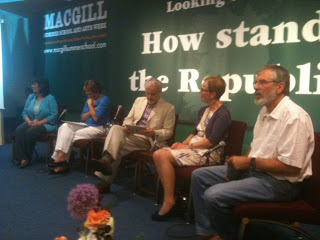 Speaking at MacGill Summer School in the Glenties Patrick MacGill was born not far from Glenties in south west Donegal. He was a poet and a novelist. At aged 12 he was sent to the Hiring Fair in Strabane where he was taken on by a wealthy Tyrone farmer. Many children of that period in Donegal frequently found themselves in Scotland working long hard hours for little return.
Speaking at MacGill Summer School in the Glenties Patrick MacGill was born not far from Glenties in south west Donegal. He was a poet and a novelist. At aged 12 he was sent to the Hiring Fair in Strabane where he was taken on by a wealthy Tyrone farmer. Many children of that period in Donegal frequently found themselves in Scotland working long hard hours for little return.MacGill worked on the railway line in Scotland and subsequently called the ‘Navvy’s poet’.
He published several volumes of poetry and in 1914 an account of the harsh life of Irish emigrant workers in Scotland. During the 1914-18 war he fought and was wounded as a British soldier. Afterward he continued to write poetry and fiction and drama.
As a tribute to this remarkable individual journalist and producer Joe Mulholland, along with some local people, established a ‘summer school’ in 1981. This isn’t a school of the kind we are all used to. It is a special, different kind of ‘school’ which brings together for one week politicians, journalists, academics, trade unionists, economists, writers, lawyers, community activists, university lecturers, and church leaders to discuss the great issues of the day.
There are other similar ‘schools’ held during the summer months – including one by An Phoblacht.
The MacGill Summer School has an international reputation. So consequently each year the Glenties plays host to a diverse range of contributors.
This year with the centenary of the 1916 Rising only three years away the organisers set as the main theme: Looking to 2016 – How stands the Republic?
I spoke on Wednesday evening in the section entitled – Envisioning a Republic of Justice, Equality and Fairness.
Not surprisingly I nailed my colours to the mast at the outset. This state is not the Republic envisaged by those who wrote the Proclamation. They had a vision for a real republic – a republic of justice, equality and fairness – a republic for all the people of this island.
This is clear when you read the Proclamation. It addresses Irish men and Irish women. At a time when women didn’t have the vote this simple address was in itself a progressive statement. Irishmen and Irishwomen is what it says.
It doesn’t say unless you are gay or unless you are a traveler or unless you are poor or unless you are disabled.
No. The Proclamation speaks of pursuing the happiness and prosperity of the whole nation and all its parts; guarantees civil and religious liberty, and equal rights and equal opportunities; and commits the republic to cherishing all the children of the nation equally.
It is also impossible to examine this issue without referencing the fact that almost 100 years ago partition created two conservative states ruled in their narrow self-interests by two conservative elites.
The northern state was a one party state which reinforced the institutionalised use of discrimination, sectarianism and segregation. And despite the significant progress arising from the peace process and the Good Friday Agreement the legacy of that structured discrimination and inequality still needs to be tackled in a focussed and systematic way.
Partition also affected the south. This state is the product of the counter-revolution that followed the Rising and of a dreadful civil war which tore out the heart of what remained of the generosity of our national spirit.
As the idealism of the aborted revolution waned a native conservative elite replaced the old English elite with little real change in the organisation of Irish society and no real movement towards a rights based dispensation. Instead conservatism ruled. Religion was hijacked by mean men who used the gospel not to empower but to control, and narrow moral codes were enforced to subvert the instinctive generosity of our people.
Women were excluded from the workplace and public life; gay and lesbian citizens were denied equality under the law and all the while scandals like the abuse in the industrial schools, the Magdalene laundries, Bethany Home and the barbaric practice of symphysiotomy were tolerated and encouraged.
The arts were censored. Our language undermined. Millions fled to England, the USA and Australia. A lesser people would not have survived.
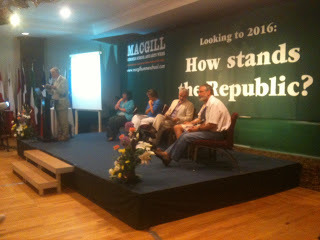
The real republic that the 1916 leaders fought and died for and which this generation seeks is a republic tolerant of the views, opinions or beliefs of others and is inclusive of all its’ people. It is a republic rooted in the core principles of 1798, of 1916 and the Democratic Programme of the First Dáil.
It is a republic that shares its wealth more equitably, looks after its’ aged and young, provides full rights for people with disabilities, liberates women and delivers the highest standards of public service.
It is a republic that has a sense of itself, will defend and enhance its language and culture and ensure that equality is the basis on which it plans, promotes and sustains the language.
A new Republic for the 21st century must mean equal rights for those in same sex relationships, ethnic minorities and those of all creeds and none. Equality and fairness must be at the heart of this. The key to building a new republic – a 32 county republic – is to begin now. The island of Ireland today is in transition. A lot of the old certainties are gone. Many of the old conservative influences have been weakened. Progress has been made.
We have the opportunity to ensure that justice, equality and fairness are core principles of a new society. We have the opportunity to win real freedom.
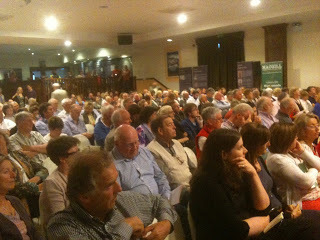
Published on August 01, 2013 17:59
July 25, 2013
Moore Street – the campaign must go on
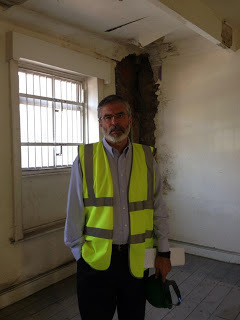
Every state holds monuments which are important to its sense of identity. This is particularly true of those states which have fought for freedom against foreign occupation and oppression. Think of the USA and the American Revolutionary War. Independence Hall in Philadelphia is where the Declaration of Independence was signed; or Faneuil Hall in Boston which was the site of speeches setting the scene for the subsequent war of independence or Paul Revere’s home. The French have the former Army ammunition dump at Les Invalides in Paris which was stormed by revolutionaries and whose weapons were then used to attack the Bastille.
The Vietnamese have their Củ Chi system of tunnels which was the base of operations for their Tết Offensive in 1968. The people of South Africa have Robben island where Madiba and other famous political prisoners courageously opposed the apartheid regime.
And on it goes. Place after place. State after state. Proud of their history. Proud of their resistance to injustice. Proud to have fought and won their freedom.
Now imagine the scandal, the outrage if Independence Hall was left to become derelict or Les Invalides had fallen into disrepair or Robben Island was abandoned to the elements?
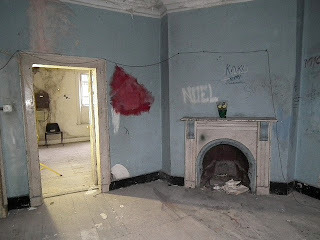
Regrettably that is what successive Irish governments have allowed to happen to 14-17 Moore Street which was accepted as a National Monument by the Irish government in 2007. This is the place where, on the Friday evening of Easter week and with the GPO in flames behind them, the surviving leaders of the 1916 Rising and the men and women of the GPO garrison escaped to. Carrying a wounded James Connolly they left the GPO by a side entrance in Henry Street. Under sustained sniper fire from British soldiers they managed to reach Moore Lane and then Moore Street.
The garrison entered number 10 and tunnelled from one house to the next until they reached no 16 – Plunket’s a poultry shop.
In a room in this terraced house the members of Provisional Irish Government held their last council of war. Pádraig Mac Piarais, Joseph Plunkett, Tom Clarke and Seán Mac Diarmada and James Connolly met to decide their next move. They had hoped to reach the Four Courts but that was clearly impossible. They looked at the possibility of storming the British Army position at Parnell Street but that too was ruled out.
Finally they decided that the only sensible course of action open to them was to surrender and Elizabeth O’Farrell was given the arduous and dangerous task of making her way to the British lines. She met the British General Lowe in Tom Clarke’s shop a short distance away in Parnell Street and a short time later Pearse signed the surrender document at the Moore Street barricade.
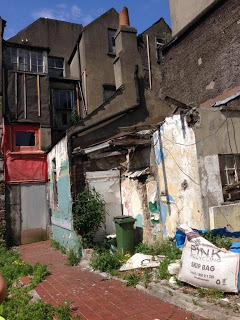
These are what Taoiseach Enda Kenny aptly described in a debate with me in the Dáil as ‘the laneways of history’. This is the ‘battlefield site of 1916’ but much of it is to be concreted over to make way for a shopping mall!
Last week I was among a delegation of Oireachtas members who visited the national monument in Moore Street. I was shocked and dismayed by the condition of the buildings. They stand in a state of considerable dereliction and decay. No other state in the world would allow such an iconic national monument to deteriorate into such a shameful condition. The roofs are in poor condition; there are serious structural problems with ceilings and walls, and dampness is everywhere; joists are severely decayed and some floors are unstable and have sagged, and there is substantial rot in timber rafters.
On the same day as our visit the Minister of Arts, Heritage and Gaeltacht Jimmy Deenihan TD announced his proposals for the preservation and development of 14-17 Moore Street which I welcome but these proposals exclude the battlefield site which is disappointing.
The Minister’s decision changes important aspects of the plan by the owners of the site, Chartered Lands. This company is owned by Joseph O’Reilly who has been described in the media as ‘NAMA’s largest client with debts of close to €3bn’ and who is paid a salary of €200,000 out of the public purse by NAMA.
The Minister’s changes are in part good news. He has consented to works on the National Monument which, he states, ‘are considered necessary for the conservation and preservation of the National Monument’.
The work consented to seems consistent with the preservation and restoration of the National Monument and the development of the commemorative centre.
However, the Minister has also consented to the demolition of Numbers 13, 18 and 19 Moore Street on the grounds that they are post-1916 structures. This facilitates the destruction of the terrace 10-25 Moore Street. This means that he has confined himself to his remit under the National Monuments Act to 14 to 17 Moore Street alone. He has not acted on his overall responsibility as Heritage Minister to preserve this historic area – Moore Street and the ‘laneways of history’ behind it, the evacuation route from the GPO and the entire battlefield site.
So, the campaign to save Moore Street, led by the families of the 1916 Leaders, must continue. A delegation of TDs met the Minister this Tuesday. I told him this in our conversation.
I and the other TDs urged him to engage with all of the stakeholders – the 1916 relatives, all property owners in the area and not just Chartered Land, the National Museum, NAMA and other relevant State agencies and NGOs with the aim of framing a new plan to fully preserve the National Monument and the terrace in which it stands, but also to develop the Historic 1916 Quarter/Battlefield Site.
The preservation of the National Monument and of Moore Street and the surrounding streetscape would allow for the development of a Historic 1916 Quarter encompassing the entire Moore St/O’Connell St. area. This would have ample scope for commercial and retail development, helping to rejuvenate this neglected part of our capital.
In my view all this needs to be done quickly so that when the centenary of the 1916 Rising takes place that Moore Street and its environs will be a place every Irish man and woman will be proud to visit.
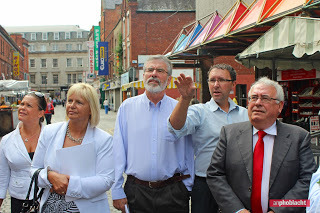
Published on July 25, 2013 08:24
Gerry Adams's Blog
- Gerry Adams's profile
- 29 followers
Gerry Adams isn't a Goodreads Author
(yet),
but they
do have a blog,
so here are some recent posts imported from
their feed.



